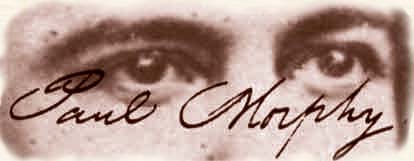

| THE LIFE AND CHESS OF PAUL MORPHY Paul meets Anderssen |
|
When Anderssen arrived on Wednesday, Paul was still confined to bed and as a result, Anderssen wanted to postpone, even cancel, the match. But Morphy wouldn't hear of it and the match was set to commence on the following Monday with the first person to win seven games declared the winner. Since Anderssen had never been to Paris, Edge showed him around and, while they visited some sites such as the Louvre, Anderssen gravitated toward to Café de la Régence where he met his old nemesis, Harrwitz, who was also originally from Breslau. They got into a friendly argument over who had won the most games between them in the past and decided to settle it over the board. The result of their six games was Anderssen 3, Harrwitz 1 and 2 draws. The match was to begin on Monday at 12:00 noon in a special room at Morphy's hotel, the Breteuil at 1 Rue du Dauphin. A few blocks away the crowd was so large that three boards were set up at the Café de la Régence so everyone could see and the moves were carried by messenger every half hour. The only ones present in the room itself were Eugène Lequesne, Saint Amant, Jules Arnous De Rivière, Jean Prèti, Paul Journoud (1821-1882, edited La Régence, La Nouvelle Régence, Le Palemède and Le Sphinx), Carlini, Frederick Edge, Jas. Mortimer and Dr. Johnson (New York Times correspondent).
Anderssen arrived on time but Morphy was late:
Dr. Johnson also observed the two contestants and gave the following description:
Anderssen left Paris on January 2, 1859 with the expectation of Morphy traveling to Germany in the spring:
and it seems that Edge had the same expectation:
But such hopes never materialized. As good an impression that Morphy made on Anderssen, Anderssen in turn made an equally good impression on all those he met.According to Edge:
Anderssen's own observations about Morphy according to Edge:
After defeating Anderssen, Morphy's distaste for chess, especially chess politics, became more and more obvious. Before leaving for Europe, he had offered odds of Pawn and Move (usually meaning he would play black and remove his Queen's Knight's pawn) to any American player. Now he extended that challenge to the world, including Harrwitz and Staunton.
Rivière engaged Morphy to collaborate on a treatise analyzing chess openings. Before they had gotten too far along in this project, Paul's brother-in-law, John D. Sybrandt, who was in Europe on business, on the direction of Morphy's family, came to Paris to try to hasten Paul's return to America. A hastily planned farewell banquet was arranged at Pestel's Restaurant. Frederick Edge and Morphy had some sort of falling out, the reasons for which can only be speculated. Edge was beginning his book on Morphy. It's possible that Morphy has seen a draft and the idea of the publicity and the possible treatment by Edge of certain events, such as the Staunton affair, might not have seemed suitable to Morphy. It is known that Morphy issued a statement in the July 1859 issue of Chess Monthly stating: "Mr. Morphy expressly disclaims any connection with it [Edge's book, The Exploits and Triumphs in Europe of Paul Morphy] in any way or manner. There are many passages that might well have been omitted; there are many more which might well have been rewritten." At any rate, shortly after the Anderssen match, Edge and Morphy parted ways.
On April 6, Morphy, Sybrandt and Rivière left Paris for England. Morphy attended some affairs and played a number of games at odds. On April 13, he gave an eight board blindfold exhibition at the London Chess Club. His opponents, in board order, were : George Walker, F. L. Slous, F. E. Greenaway, F. G. Janssens, Mongredian, G. W. Medley, G. Maude and J. P. Jones. Among the spectators were Rivière, Löwenthal, Lord Arthur Hay, Marmaduke Wyvill, Barnes and Boden. Morphy won 2, drew 1 (against Walker) and the rest were discontinued due to the lateness of the hour. (the exhibition lasted from 5:00 pm until 1:00 am) On April 20, Morphy gave another eight board blindfold exhibition at St. George's. His opponents, in board order, were: Lord Cremorne, Capt. Kennedy, H. G. Cattley, Lord Arthur Hay, T. H. Worrall, J. Cunningham, G. Thrupp and Thomas Barnes. The exhibition lasted from 2:00 - 6:30 with Morphy winning 5 and drawing 3. Between the exhibition on April 20 and April 24, Morphy played many casual games and a 9 game match against Worrell at Knight odds, winning 7-2. Then on April 26, he played a 5 board simultaneous exhibition (sighted -
noteworthy since this was the only one of his career) against , in board
order, Rivière, Boden, Barnes, Bird and Löwenthal.
It's been pointed out that in the only game
Morphy lost (against Barnes), he had missed a clear win:
In the July 11, 1884 edition of the New Orleans Times-Democrat, of which Charles Maurian was the chess editor, in a memorial column, it stated: "In a game with the Queen of England he gallantly permitted Her Majesty to win, but with Napoleon III, he was less gallant."Nothing more is known for sure about his play with either monarch.
On April 30, he boarded the Persia bound for New York, never to return to England.
The Steamship Persia, built in1856 by Robert Napier & Sons, Glasgow for the Cunard Steamship Company, was the fastest vessel in it's time to cross the Atlantic - just 8 days. It cost £130,000 to build, had a cargo capacity 1,050 tons and could carry 200 passengers.
|